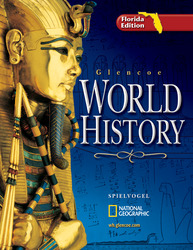Glencoe World History, Florida EditionChapter 1:
The First Humans, Prehistory–3500 B.C.Chapter OverviewsThe first humans lived in small communities that were focused on very basic needs—food, shelter, and safety. Early humans left no written record of their activities and thoughts. Without such records, archaeologists and anthropologists have had to rely on fossils, artifacts, and skeletal remains to develop theories about the lives of early humans. Researchers have concluded that the earliest humans lived a meager hunter-gatherer existence. Only later did they develop the skills and tools necessary to engage in agriculture and to build the first civilizations. Section 1 Early Humans
Our knowledge of the earliest humans, or hominids, is based on discoveries of fossils and artifacts. Each new archaeological find helps scientists improve their theories about how prehistoric humans lived and died. Scientists believe the earliest humanlike creatures lived in Africa three to four million years ago. Over the next several million years, more advanced species appeared, first Homo erectus, then Homo sapiens. From Homo sapiens, subgroups emerged. Today, all humans belong to the subspecies Homo sapiens sapiens. Each surviving species and subgroup used more advanced skills and tools than the last. During the Paleolithic Age (2,500,000 to 10,000 B.C.), humans invented tools that helped them become better hunters. Improved types of shelter and the use of fire to keep warm also improved their survival skills. This allowed them to migrate to colder climates. Discoveries of cave paintings from as long ago as 25,000 B.C. show that art was part of the simple culture of the hunters and gatherers of the Paleolithic Age. Section 2 The Neolithic Revolution and the Rise of Civilization
The Neolithic Revolution, the period of human history from 10,000 to 4000 B.C., is marked by the rise of systematic agriculture—the domestication of animals and the growing of crops on a regular basis. Systematic agriculture often resulted in the production of more crops than local people could consume. This meant that some people could leave farming and work in trades and crafts. During the last stages of the Neolithic Age, craftspeople discovered ways of making improved tools and weapons using copper and later bronze. Historians speak of a Bronze Age from 3000 to 1200 B.C. Specialization of labor led to the trading of goods and a diversified economy. Civilizations emerged in response to these changes. Civilizations are complex cultures in which large numbers of human beings share a number of common elements. Historians have identified the basic characteristics of civilizations. They include cities, government, religion, art, social structure, and writing.
 | 

















